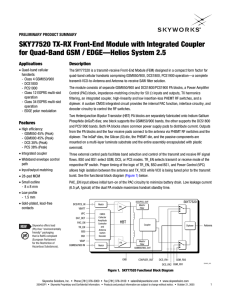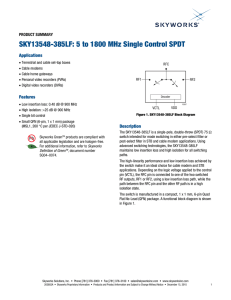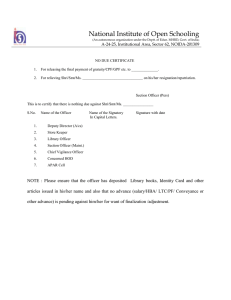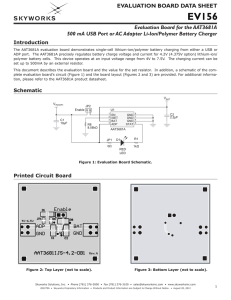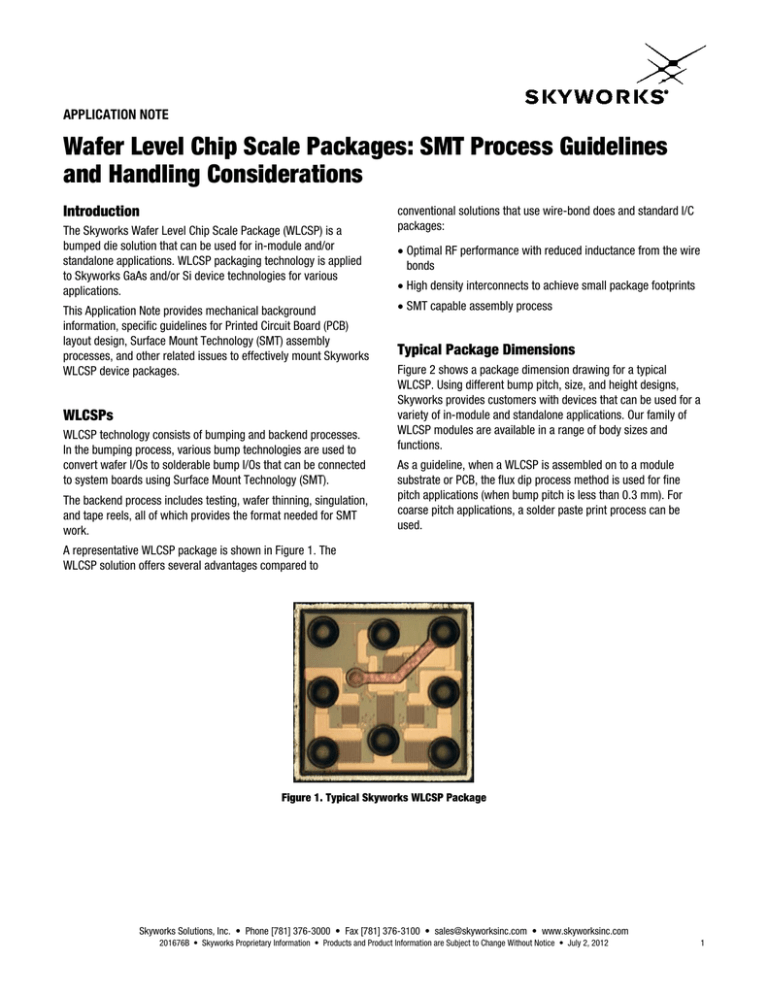
APPLICATION NOTE
Wafer Level Chip Scale Packages: SMT Process Guidelines
and Handling Considerations
Introduction
The Skyworks Wafer Level Chip Scale Package (WLCSP) is a
bumped die solution that can be used for in-module and/or
standalone applications. WLCSP packaging technology is applied
to Skyworks GaAs and/or Si device technologies for various
applications.
This Application Note provides mechanical background
information, specific guidelines for Printed Circuit Board (PCB)
layout design, Surface Mount Technology (SMT) assembly
processes, and other related issues to effectively mount Skyworks
WLCSP device packages.
WLCSPs
WLCSP technology consists of bumping and backend processes.
In the bumping process, various bump technologies are used to
convert wafer I/Os to solderable bump I/Os that can be connected
to system boards using Surface Mount Technology (SMT).
The backend process includes testing, wafer thinning, singulation,
and tape reels, all of which provides the format needed for SMT
work.
conventional solutions that use wire-bond does and standard I/C
packages:
• Optimal RF performance with reduced inductance from the wire
bonds
• High density interconnects to achieve small package footprints
• SMT capable assembly process
Typical Package Dimensions
Figure 2 shows a package dimension drawing for a typical
WLCSP. Using different bump pitch, size, and height designs,
Skyworks provides customers with devices that can be used for a
variety of in-module and standalone applications. Our family of
WLCSP modules are available in a range of body sizes and
functions.
As a guideline, when a WLCSP is assembled on to a module
substrate or PCB, the flux dip process method is used for fine
pitch applications (when bump pitch is less than 0.3 mm). For
coarse pitch applications, a solder paste print process can be
used.
A representative WLCSP package is shown in Figure 1. The
WLCSP solution offers several advantages compared to
Figure 1. Typical Skyworks WLCSP Package
Skyworks Solutions, Inc. • Phone [781] 376-3000 • Fax [781] 376-3100 • sales@skyworksinc.com • www.skyworksinc.com
201676B • Skyworks Proprietary Information • Products and Product Information are Subject to Change Without Notice • July 2, 2012
1
APPLICATION NOTE • PCB DESIGN AND SMT ASSEMBLY GUIDELINES FOR WLCSPS
Figure 2. Typical WLCSP Package Dimensions
Figure 3. Substrate Design for 0.25 mm Pitch WLCSP (Metal Defined Pads Used)
Substrate Design Guidelines
Substrate Terminal Pads
The substrate pads of a WLCSP should be metal defined or nonsolder mask defined (NSMD) pads. Figure 3 shows a typical or
representative substrate drawing for an 0.25 mm pitch WLCSP
with the following dimensions for an in-module application:
Metal defined pad:
Metal pad diameter (a) = 100 μm
Metal trace width (b) = 80 μm
2
Substrate solder mask design (solder mask patch):
Solder mask width (c) = 160 μm
Solder mask pull-back from die edge (d) = 100 μm
Solder mask pull-back from metal pad edge (e) = 30 μm
To achieve adequate underfill after the WLCSP attachment, the
solder mask at the edge of the module should be pulled back
100 microns to provide more space for the underfill material
(epoxy or mold compound) to flow under the module. This creates
an underfill with minimal voids.
Skyworks Solutions, Inc. • Phone [781] 376-3000 • Fax [781] 376-3100 • sales@skyworksinc.com • www.skyworksinc.com
July 2, 2012 • Skyworks Proprietary Information • Products and Product Information are Subject to Change Without Notice • 201676B
APPLICATION NOTE • PCB DESIGN AND SMT ASSEMBLY GUIDELINES FOR WLCSPS
SMT Assembly Guidelines
Stencil Design
For a WLCSP with a bump pitch of 0.25 mm and a metal pad
diameter of 0.1 mm, the flux dip assembly method is used. In the
case of flux printing assembly, a flux stencil is required. The
stencil design should be a 1:1 match for the dimensions and
locations that are used in substrate metal pad designs.
Stencil design guidelines vary according to the WLCSP
configuration. Specific stencil design requirements are provided in
Skyworks product Data Sheets.
SMT Pick and Place
The WLCSP package is a small package relative to a typical SMT
package. For better accuracy, it is recommended to use
automated fine-pitch placement machines with vision alignment
to place the parts. Local fiducials are required on the board to
support the vision systems and achieve placement accuracy.
“Pick and place” systems using mechanical centering are not
recommended due to the high potential for mechanical damage to
the WLCSP device. Ensure minimal pick and place force (typically
< 0.5 N) is used to avoid damage, with all vertical compression
forces controlled and monitored. Z-height control methods are
recommended over force control.
Skyworks highly recommends the use of low-force nozzle options
and compliant materials (e.g., rubber tipped) to further avoid any
physical damage to the WLCSP device. Use only vacuum pencils
with soft tip materials whenever manual handling is required.
All assemblers of WLCSP components are encouraged to conduct
placement accuracy studies to ensure adequate compensation is
provided for achieving high accuracy placement.
Due to the wide range of equipment and process parameters
available including nozzle selection, and pick and place forces,
Skyworks cannot provide specific SMT process parameters for
each application. Skyworks recommends the assembler perform
an adequate validation of the SMT pick and place process to
ensure WLCSP die integrity is not compromised.
SMT Reflow Profile
Common infrared or convection reflow SMT processes are used
for the assembly. Since most WLCSP modules are rated at a
Moisture Sensitivity Level (MSL) of 1, no pre-baking is required
before the assembly. Standard SMT reflow profiles, as shown in
Figures 4 and 5, can be used to surface-mount the WLCSP
modules on to the substrate. Ranges of recommended parameters
for the SMT reflow profiles shown in Figures 4 and 5 are listed in
Tables 1 and 2. Solder paste manufacturer’s recommendations
should also be considered to determine the proper reflow profile.
NOTE: The maximum peak reflow temperature for a specific part
is found in the device Data Sheet.
In all cases, a temperature gradient of 3 °C/sec or less should be
maintained to prevent warpage of the package and to ensure that
all joints reflow properly. Additional soak time and slower
preheating time may be required to improve the out-gassing of
solder paste.
The reflow profile also depends on the PCB density and the type of
solder paste used. Final adjustments of the reflow profile should
be made according to the device’s application requirements.
Standard no-clean solder paste is generally recommended. If
another type of flux is used, removal of flux residual may be
necessary.
If solder balling occurs during reflow, the paste aperture may be
decreased to reduce the amount of paste deposited to the PCB.
Nitrogen may also be used to help counteract the tendency of the
paste to form solder balls.
During the assembly process, the PCB must be supported properly
to ensure board flatness. Typically, supports under the board are
provided at each workstation but are not always available in a
conveyor system. When thin or large boards are populated with
components, the weight of the board, itself, plus the weight of the
components may deform the PCB in reflow operation and cause
the board to sag. This effect may shift a component from a
designated location on the board after placement. Consequently,
there is a large variation in solder joint height, which increases the
potential for solder joint defects such as “bridging” and “opens.”
Generally, carriers need to be designed and used for large or thin
boards to ensure proper board flatness.
Although a certain amount of voids do occur in the solder joints, a
20 percent voiding distributed across the solder joints as small
voids should be acceptable.
Assembly Considerations
WLCSPs are more susceptible to mishandling and processingrelated Mechanical-Over-Stress (MOS) issues than conventional
molded chip and wire packages. Care must be exercised
throughout the transportation, inventory, staging, and
manufacturing operations to ensure that the parts are not
damaged. Experience has shown that all persons involved and
associated with material handling and manufacturing should be
trained in the proper methods and techniques of handling WLCSPs
to avoid incidental damage.
All semiconductor devices, whether packaged or unpackaged,
may be inadvertently damaged by static discharges. These
charges can build up on any insulating surface, including the
operator’s hair and clothing, and are measured in tens of
thousands of volts. Just touching any of the connections on an
grounded component can induce tunneling defects in the internal
dielectric layers. The best way to avoid this is to ensure that all
operators, tools, and equipment are suitably grounded before any
contact is made.
Skyworks Solutions, Inc. • Phone [781] 376-3000 • Fax [781] 376-3100 • sales@skyworksinc.com • www.skyworksinc.com
201676B • Skyworks Proprietary Information • Products and Product Information are Subject to Change Without Notice • July 2, 2012
3
APPLICATION NOTE • PCB DESIGN AND SMT ASSEMBLY GUIDELINES FOR WLCSPS
Figure 4. Typical SMT Reflow Profile for Maximum Temperature of 250 °C
Table 1. Typical 250 °C SMT Reflow Profile Parameters
Parameter
4
Convection or Infrared/Convection
Average ramp-up rate
3 °C/sec maximum
Preheat temperature = 175 ± 25 °C
60 to 180 seconds
Temperature maintained above 217 °C
60 to 150 seconds
Time between 245 °C and 250 °C (peak temperature)
10 to 20 seconds
Peak temperature range
250 (+0/–5) °C or 245 (+5/–0) °C
Ramp-down rate
6 °C/sec maximum
Time from 25 °C to peak temperature
480 seconds maximum
Skyworks Solutions, Inc. • Phone [781] 376-3000 • Fax [781] 376-3100 • sales@skyworksinc.com • www.skyworksinc.com
July 2, 2012 • Skyworks Proprietary Information • Products and Product Information are Subject to Change Without Notice • 201676B
APPLICATION NOTE • PCB DESIGN AND SMT ASSEMBLY GUIDELINES FOR WLCSPS
Figure 5. Typical SMT Reflow Profile for Maximum Temperature of 260 °C
Table 2. Typical 260 °C SMT Reflow Profile Parameters
Parameter
Convection or Infrared/Convection
Average ramp-up rate
3 °C/sec maximum
Preheat temperature = 175 ± 25 °C
60 to 180 seconds
Temperature maintained above 217 °C
60 to 150 seconds
Time between 255 °C and 260 °C (peak temperature)
10 to 20 seconds
Peak temperature range
260 (+0/–5) °C or 255 (+5/–0) °C
Ramp-down rate
6 °C/sec maximum
Time from 25 °C to peak temperature
480 seconds maximum
Skyworks Solutions, Inc. • Phone [781] 376-3000 • Fax [781] 376-3100 • sales@skyworksinc.com • www.skyworksinc.com
201676B • Skyworks Proprietary Information • Products and Product Information are Subject to Change Without Notice • July 2, 2012
5
APPLICATION NOTE • PCB DESIGN AND SMT ASSEMBLY GUIDELINES FOR WLCSPS
I/Cs are also vulnerable to oxidation, contamination, and
mechanical damage. Wafer clam shells should only be opened
and handled in approved work stations that are ESD compliant.
Loose units outside of the original packing should be considered
compromised and should be scrapped. The original packing
materials have been selected to provide adequate protection for
WLCSP packages through a normal distribution and manufacturing
process.
Repacking of Skyworks products into other packaging or into
other intermediate containers is not recommended and can
potentially void Skyworks product warranty. Skyworks factory
packing does not protect the WLCSPs from damage in extreme or
excessive cases. Boxes and ring frames & hoop rings should not
be dropped, impacted or exposed to crushing forces.
Susceptibility to Mechanical Over Stress
Due to the properties of silicon, GaAs and other semiconductor
materials used in WLCSP packages are are brittle and subject to
MOS damage during handling and assembly processes.
Underfill
Although underfilling WLCSPs is often considered to be
undesirable due to the added process complexity and cost, it has
been demonstrated to be beneficial in board level reliability testing
that includes thermal cycling, drop testing, and board bending
performance.
As a result, underfills have been effectively used to improve solder
joint reliability. Underfills enhance WLCSP board level reliability
with the impact conditions associated with mobile electronics. A
number of applications demand high reliability, which include
medical, automotive, industrial, and military electronics. The
decision to select and use a specific underfill should be carefully
considered and the effectiveness of the desired underfill should be
evaluated by the customer.
Packing: The WLCSP devices used in high volume SMT
applications are generally supplied on film frame on a UV dicing
tape. WLCSPs are provided in a bump-up configuration. Adequate
steps should be taken to ensure proper UV exposure is performed
before the die pick application.
Unlike conventionally packaged parts, WLCSPs could be rendered
nonfunctional or unreliable by even moderate MOS damage. Care
must be taken in design, handling, and manufacturing to ensure
that WLCSPs are adequately protected against impacts and
mechanical stresses. Typical mechanical stress and its effects on
die integrity are highlighted in Table 3.
Table 3. Typical Mechanical Stresses and Effects on Die Integrity
Force Moments
6
Force Representation
Potential Sources
Prevention/Mitigation for
Decreasing Force Movement
Compressive forces
Mishandling in tape,
Mishandling during and after SMT,
Excessive placement force
Observe proper handling protocols,
Backside tape lamination underfill,
Optimization of SMT process
Flexture
Board flexing during and after SMT,
Drop and vibration forces,
Excessive Coefficient of Thermal
Expansion (CTE) mismatch
Observe proper handling protocols,
Backside tape lamination,
Optimize fixturing,
Optimization of SMT process
Impact
Mishandling in tape,
Pick and place process errors,
Mishandling during and after SMT
Observe proper handling,
Underfill,
Backside tape lamination
Skyworks Solutions, Inc. • Phone [781] 376-3000 • Fax [781] 376-3100 • sales@skyworksinc.com • www.skyworksinc.com
July 2, 2012 • Skyworks Proprietary Information • Products and Product Information are Subject to Change Without Notice • 201676B
APPLICATION NOTE • PCB DESIGN AND SMT ASSEMBLY GUIDELINES FOR WLCSPS
Copyright © 2011, 2012 Skyworks Solutions, Inc. All Rights Reserved.
Information in this document is provided in connection with Skyworks Solutions, Inc. (“Skyworks”) products or services. These materials, including the information contained herein, are provided by
Skyworks as a service to its customers and may be used for informational purposes only by the customer. Skyworks assumes no responsibility for errors or omissions in these materials or the
information contained herein. Skyworks may change its documentation, products, services, specifications or product descriptions at any time, without notice. Skyworks makes no commitment to
update the materials or information and shall have no responsibility whatsoever for conflicts, incompatibilities, or other difficulties arising from any future changes.
No license, whether express, implied, by estoppel or otherwise, is granted to any intellectual property rights by this document. Skyworks assumes no liability for any materials, products or
information provided hereunder, including the sale, distribution, reproduction or use of Skyworks products, information or materials, except as may be provided in Skyworks Terms and Conditions of
Sale.
THE MATERIALS, PRODUCTS AND INFORMATION ARE PROVIDED “AS IS” WITHOUT WARRANTY OF ANY KIND, WHETHER EXPRESS, IMPLIED, STATUTORY, OR OTHERWISE, INCLUDING FITNESS FOR A
PARTICULAR PURPOSE OR USE, MERCHANTABILITY, PERFORMANCE, QUALITY OR NON-INFRINGEMENT OF ANY INTELLECTUAL PROPERTY RIGHT; ALL SUCH WARRANTIES ARE HEREBY EXPRESSLY
DISCLAIMED. SKYWORKS DOES NOT WARRANT THE ACCURACY OR COMPLETENESS OF THE INFORMATION, TEXT, GRAPHICS OR OTHER ITEMS CONTAINED WITHIN THESE MATERIALS. SKYWORKS
SHALL NOT BE LIABLE FOR ANY DAMAGES, INCLUDING BUT NOT LIMITED TO ANY SPECIAL, INDIRECT, INCIDENTAL, STATUTORY, OR CONSEQUENTIAL DAMAGES, INCLUDING WITHOUT LIMITATION,
LOST REVENUES OR LOST PROFITS THAT MAY RESULT FROM THE USE OF THE MATERIALS OR INFORMATION, WHETHER OR NOT THE RECIPIENT OF MATERIALS HAS BEEN ADVISED OF THE
POSSIBILITY OF SUCH DAMAGE.
Skyworks products are not intended for use in medical, lifesaving or life-sustaining applications, or other equipment in which the failure of the Skyworks products could lead to personal injury,
death, physical or environmental damage. Skyworks customers using or selling Skyworks products for use in such applications do so at their own risk and agree to fully indemnify Skyworks for any
damages resulting from such improper use or sale.
Customers are responsible for their products and applications using Skyworks products, which may deviate from published specifications as a result of design defects, errors, or operation of
products outside of published parameters or design specifications. Customers should include design and operating safeguards to minimize these and other risks. Skyworks assumes no liability for
applications assistance, customer product design, or damage to any equipment resulting from the use of Skyworks products outside of stated published specifications or parameters.
Skyworks, the Skyworks symbol, and “Breakthrough Simplicity” are trademarks or registered trademarks of Skyworks Solutions, Inc., in the United States and other countries. Third-party brands
and names are for identification purposes only, and are the property of their respective owners. Additional information, including relevant terms and conditions, posted at www.skyworksinc.com,
are incorporated by reference.
Skyworks Solutions, Inc. • Phone [781] 376-3000 • Fax [781] 376-3100 • sales@skyworksinc.com • www.skyworksinc.com
201676B • Skyworks Proprietary Information • Products and Product Information are Subject to Change Without Notice • July 2, 2012
7


